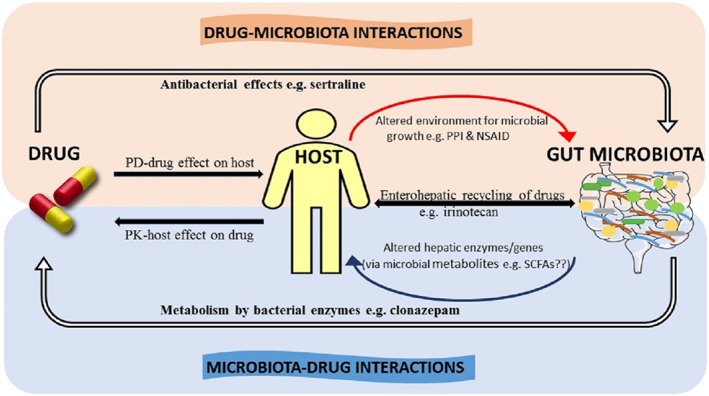Figure 1.

The complex interplay between drugs and the gut microbiota. The reciprocal relationship between drugs and the gut microbiome is composed of both microbiota‐mediated alterations to drug pharmacokinetics and drug‐mediated alterations to the function and composition of the gut microbiome. These interactions can occur by both direct (illustrated by solid white arrows with black outline) and indirect or secondary (illustrated by curved line arrows) mechanisms. ‘Microbiota–Drug Interactions’: the microbiota can directly metabolize drugs through bacterial‐derived enzymes (e.g. nitroreductase‐mediated metabolism of clonazepam) but can also indirectly affect drug metabolism through the alteration of the hosts capacity to metabolize drugs (curved‐up line arrow), potentially altering drug PK profile. Microbial‐derived metabolites (e.g. SCFAs and secondary bile acids) may be potential mediators of this effect. The interactions between the host and gut microbiome are responsible for the enterohepatic recirculation of drugs. For example, the hepatic‐glucuronidated irinotecan metabolite is deconjugated by β‐glucuronidase enzymes expressed by the gut microbiota. ‘Drug–Microbiota Interactions’: the mechanisms underpinning the drug‐mediated changes to the function and composition the gut microbiome are yet to be fully elucidated. Drugs can have antibacterial properties that directly affect the composition of the gut microbiota (e.g. sertraline). Drugs can also alter the physiological properties or functions of host organs (i.e. PD effect) (e.g. PPI‐mediated alterations to gastric acid production and pH, NSAID‐induced changes to mucosal integrity), which may, in turn, precipitate secondary effects on the composition of the gut microbiota (illustrated by the curved‐down line arrow).
